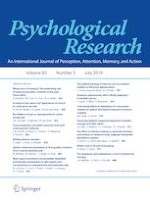10-08-2017 | Original Article
Spatial–numerical associations in first-graders: evidence from a manual-pointing task
Gepubliceerd in: Psychological Research | Uitgave 5/2019
Log in om toegang te krijgenAbstract
The current study investigated whether children’s mental representations of numbers are organized spatially at the onset of formal schooling using a manual-pointing task. First-graders (N = 77) saw four numbers (1, 3, 7, 9) presented randomly in four spatial positions (extreme left, left, right, extreme right) on a touch screen. In a Go/No-Go task, children were asked to press the appearing numbers as fast and accurately as possible, but only when the numbers were “smaller” (or “larger” in a different block) than 5. Results indicated that response times were significantly affected by the spatial position in which the different numbers were presented. Response times for small numbers (1 and 3) increased and response times for large numbers (7 and 9) decreased, the more they were presented towards the right side of the screen. These findings suggested that first-graders spontaneously employed a spatial number representation that was oriented from left to right. Furthermore, this left-to-right organization could not be easily changed by priming a different direction. Our findings indicate that even young children map numbers continuously onto space.
